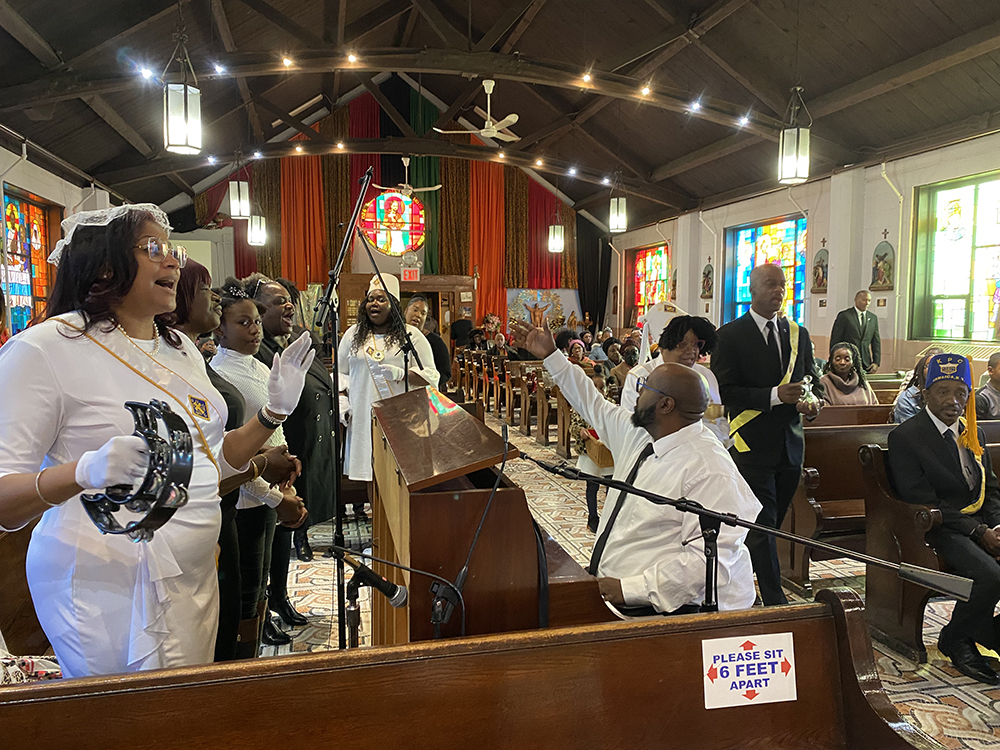
SOUTH JAMAICA — This neighborhood, nicknamed “Southside” for its location south of downtown Jamaica, was a hotbed of murderous drug activity in the 1970s and 1980s.
To be sure, drug trafficking and violence still exist in South Jamaica, a neighborhood with a predominantly black population. But according to NYPD data, major crime there is down 85% from the crack epidemic’s peak in 1990.
Meanwhile, churches are everywhere in the neighborhood. A block away from St. Benedict the Moor Catholic Church is the Greater Allen AME Cathedral of New York.
And “storefront” churches occupy spots on surrounding streets — even as national polls show that attendance at religious services for most denominations has plummeted throughout the U.S. in recent years, including the Catholic Church.
But parishioners at one local parish, St. Bonaventure-St. Benedict the Moor, want to reverse these trends.
“We have problems with guns, with drugs, with prostitution, but at the same time, we have tons of churches,” said Father Chris Piasta, the new pastor. “How do these two things coexist?” His only explanation is that a hunger for God’s word persists across this neighborhood.
Therein lies an opportunity, Father Piasta said, to fill the churches and grow the kingdom of God.
St. Bonaventure on 170th Street, and St. Benedict the Moor on Brinkerhoff Avenue, merged in the 1990s.
Servant of God Msgr. Bernard Quinn worked to establish St. Benedict the Moor Church in 1932 for Black Catholics in Queens, 10 years after he formed a similar church for Brooklyn, St. Peter Claver.
Father Piasta formerly pastored St. Joseph’s Parish, also in Jamaica, and is a Catholic chaplain at JFK International and LaGuardia Airports. He is Polish, but lived in Germany before coming to the U.S.
Gospel is the lively soundtrack of worship at his new parish — furious piano playing by musical director Devin Olivas, with the choir singing, clapping, raising their hands, and the congregation joining in praise. “It’s a pure joy,” Father Piasta said.
Another blessing, he added, is that a core group of parishioners has kept the parish alive “through thick and thin. They take ownership into their own hands. They understand that it’s their responsibility.”
Among them, he said, is Shaniqua Wilson, who is active in various ministries, including the choir. Her family attended St. Bonaventure in her youth. Now, as an adult, she juggles her Sunday schedule to attend Mass at both churches of the parish, even though she now lives on Long Island.
“Come hell or high water, I’m going to South Jamaica on Sunday,” she said. “It is beloved to me and for many others. For people between the ages of 35 and 50, this has been a safe haven, despite the crack era we grew up in.”
Church leadership has given Wilson an up-close view of declining Mass attendance.
A 2020 Pew Research Center poll showed that only about a quarter (27%) of Black Catholics in the U.S. attend Mass weekly. White and Hispanic Catholics reported similar data — 31% and 27%, respectively.
COVID-19, she added, deepened the problem. “It’s been hard to get some of those Catholics to come back,” Wilson said. “And I think a lot of churches are facing this.”
Some members left to worship elsewhere, although many who did leave have returned, those who stayed pointed out.
“I think that it strengthened our community and reinforced the fact that this is our church,” Wilson said. “Yes, the bishop will send a man of God to come and shepherd us, but ultimately it’s on us.”
The U.S. Conference of Catholic Bishops reports that of the nearly 180 parishes in Brooklyn and Queens, 25 have memberships that are “predominantly African American.”
Such parishes are where “religious engagement” is heightened for Black Catholics, according to the USCCB’s Subcommittee on African American Affairs.
Father Alonzo Cox has confirmed this is true. He is vicar of Black Catholic Concerns and the coordinator of the Ministry for African American Catholics in the diocese.
“Many Black Catholics just want to hear the word of God proclaimed, and want to hear some good preaching,” he said. “If you’re in a dominantly black parish, no one is going to complain if the priest or deacon preaches for 15-20 minutes.”
